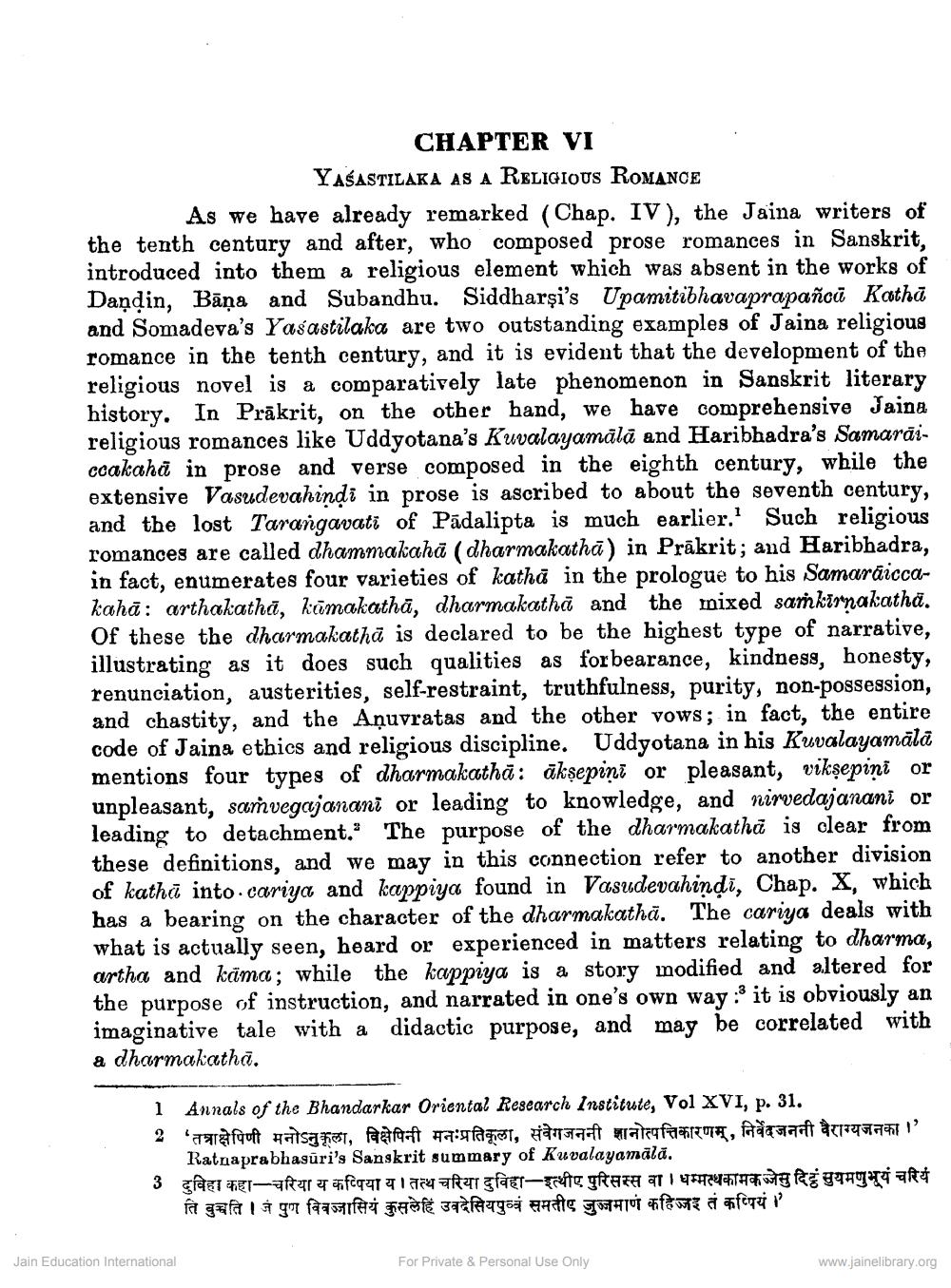________________
CHAPTER VI
YASASTILAKA AS A RELIGIOUS ROMANCE
As we have already remarked (Chap. IV), the Jaina writers of the tenth century and after, who composed prose romances in Sanskrit, introduced into them a religious element which was absent in the works of Dandin, Bāṇa and Subandhu. Siddharşi's Upamitibhavaprapañcā Kathā and Somadeva's Yasastilaka are two outstanding examples of Jaina religious romance in the tenth century, and it is evident that the development of the religious novel is a comparatively late phenomenon in Sanskrit literary history. In Prakrit, on the other hand, we have comprehensive Jaina religious romances like Uddyotana's Kuvalayamālā and Haribhadra's Samaraiccakaha in prose and verse composed in the eighth century, while the extensive Vasudevahindi in prose is ascribed to about the seventh century, and the lost Tarangavati of Padalipta is much earlier. Such religious romances are called dhammakahā (dharmakatha) in Prakrit; and Haribhadra, in fact, enumerates four varieties of katha in the prologue to his Samaraiccakaha: arthakatha, kamakatha, dharmakatha and the mixed samkirnakatha. Of these the dharmakatha is declared to be the highest type of narrative, illustrating as it does such qualities as forbearance, kindness, honesty, renunciation, austerities, self-restraint, truthfulness, purity, non-possession, and chastity, and the Anuvratas and the other vows; in fact, the entire code of Jaina ethics and religious discipline. Uddyotana in his Kuvalayamālā mentions four types of dharmakatha: ākṣepini or pleasant, vikṣepini or unpleasant, samvegajanani or leading to knowledge, and nirvedajanani or leading to detachment." The purpose of the dharmakatha is clear from these definitions, and we may in this connection refer to another division of katha into cariya and kappiya found in Vasudevahindi, Chap. X, which has a bearing on the character of the dharmakatha. The cariya deals with what is actually seen, heard or experienced in matters relating to dharma, artha and kama; while the kappiya is a story modified and altered for the purpose of instruction, and narrated in one's own way :3 it is obviously an imaginative tale with a didactic purpose, and may be correlated with a dharmakatha.
1 Annals of the Bhandarkar Oriental Research Institute, Vol XVI, p. 31.
2 ' तत्राक्षेपिणी मनोनुकूला, विक्षेपिनी मनःप्रतिकूला, संवेगजननी ज्ञानोत्पत्तिकारणम्, निर्वेदजननी वैराग्यजनका ।" Ratnaprabhasuri's Sanskrit summary of Kuvalayamālā.
3 दुविहा कहा - चरिया य कप्पिया य । तत्थ चरिया दुविहा - इत्थीए पुरिसस्स वा । धम्मस्थकामकज्जेसु दिट्टं सुयमणुभूयं चरियं ति बुच्चति । जं पुण विवज्जासियं कुसलेहिं उवदेसियपुत्रं समतीए जुज्जमाणं कहिज्जइ तं कप्पियं ।'
Jain Education International
For Private & Personal Use Only
www.jainelibrary.org




